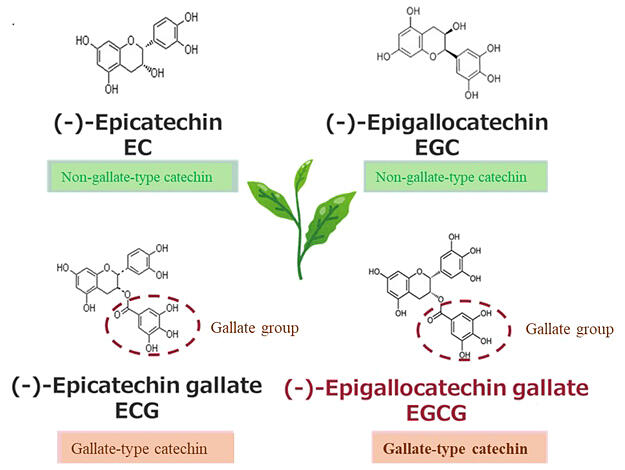A catechin present in green tea has been found to exhibit strong antibacterial activity against plaque bacteria, a pathogenic cause of periodontal disease. A research group led by Professor Nobuhiro Takahashi, Associate Professor Jumpei Washio, Assistant Professor Yuki Abiko, and Graduate Student Mayu Higuchi of the Division of Oral Ecology and Biochemistry at Tohoku University Graduate School of Dentistry, has found that epigallocatechin-3-gallate (EGCG), a catechin found in green tea, inhibits the metabolism of Porphyromonas gingivalis, Prevotella intermedia, Prevotella nigrescens, Fusobacterium nucleatum, and Fusobacterium periodontium, which are the major bacteria associated with periodontal disease, inducing growth inhibition and killing of the bacteria. These periodontal disease-associated bacteria were found to be more sensitive to EGCG than the caries-associated bacterium Streptococcus mutans and susceptible to EGCG at low concentrations. The findings are expected to contribute to the prevention of periodontal disease and maintain a good oral environment. This work was published in Archives of Oral Biology.

Provided by Tohoku University
Green tea catechins have many biological effects, including antibacterial, anticancer, and antioxidant effects. Various catechins have been known, including epicatechin (EC), epigallocatechin (EGC), epicatechin-3-gallate (ECG), and epigallocatechin-3-gallate (EGCG). Among these, EGCG is the most abundant catechin in green tea and is known to have the strongest antibacterial effect. The research group has previously reported that catechins at concentrations equivalent to those in green tea exhibit antibacterial effects against caries-associated bacteria (Streptococcus spp.), and that the combined use of fluorides and catechins may produce synergistic effects and more effectively prevent caries.
In this study, the research group clarified the bactericidal, growth-inhibiting, metabolism-inhibiting, and bacterial aggregation-promoting effects of EGCG on major periodontal disease-associated bacteria. Furthermore, these effects were compared with its effects on Streptococcus mutans, a typical caries-associated bacterium, to verify and evaluate the antibacterial effects of EGCG. Specifically, all these bacteria were killed by incubation with a 2 mg/mL EGCG solution for 4 hours. Meanwhile, the viability of S. mutans was reduced by approximately 40%. The disk diffusion method for EGCG susceptibility tests showed that the growth of periodontal disease-associated bacteria was more effectively inhibited than that of S. mutans, and the growth-inhibiting effects against P. gingivalis and Fusobacterium spp. were particularly high.
The research group surveyed the correlation of the growth-inhibiting effects with the 50% inhibitory concentrations, which indicate inhibition of bacterial metabolic activity measured by fluorescent dye-based real-time monitoring of the metabolic activity using a method developed by their laboratory. The survey revealed that EGCG inhibited the bacterial metabolic activity, suggesting that bacterial growth was inhibited as a result of reduced metabolic activity.
The group previously reported that EGCG can promote the aggregation of caries-associated bacteria. In this study, they found the same effect of EGCG on some periodontal disease-associated bacteria. This indicates that EGCG may promote bacterial aggregation and remove aggregated bacteria while they are suspended in saliva or other fluids, inhibiting the formation and maturation of oral biofilms (plaque). These results indicate that EGCG exerts the following antibacterial effects: "inducing bacterial growth inhibition and killing through inhibition of metabolism and promoting the removal of bacteria from the oral cavity through bacterial aggregation."
The bactericidal and growth-inhibiting effects of EGCG on periodontal disease-associated bacteria were found to be effective at lower concentrations than those on caries-associated bacteria such as S. mutans. One possible reason for this is that most caries-associated bacteria such as S. mutans, are Gram-positive bacteria having thick cell walls, whereas periodontal disease-associated bacteria are Gram-negative bacteria having thin cell walls and are more susceptible to EGCG-induced damage. The research group will examine the specific mechanism in the future.
Journal Information
Publication: Archives of Oral Biology
Title: Antimicrobial effects of epigallocatechin-3-gallate, a catechin abundant in green tea, on periodontal disease-associated bacteria
DOI: 10.1016/j.archoralbio.2024.106063
This article has been translated by JST with permission from The Science News Ltd. (https://sci-news.co.jp/). Unauthorized reproduction of the article and photographs is prohibited.




